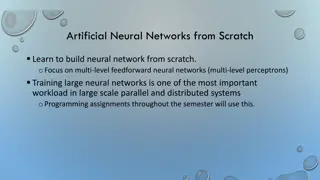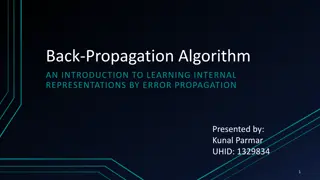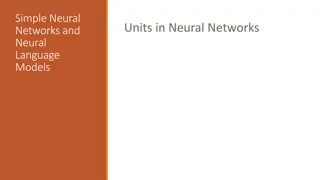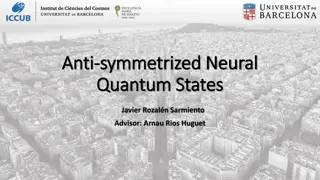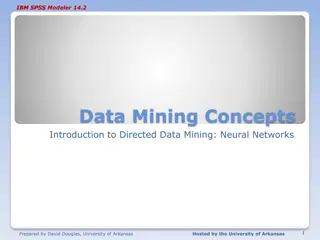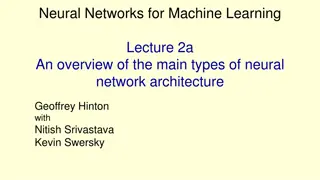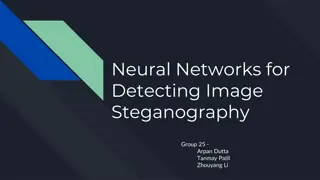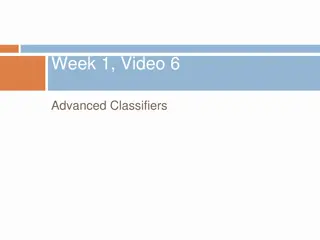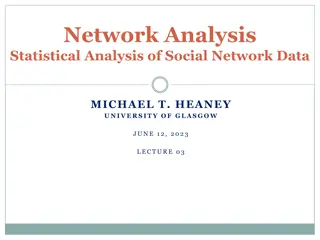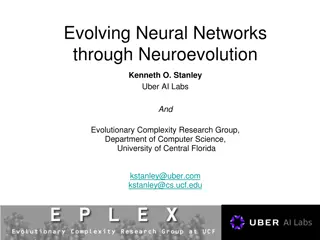of Neural Networks:
This lesson plan for Grade 8 focuses on graphing linear equations in slope-intercept form. It covers learners' characteristics, entry skills, state objectives, teacher-student interaction, substitution activities, and motivational exercises to enhance understanding. Utilizing visual aids and engaging activities, students will develop proficiency in graphing linear equations efficiently.
Download Presentation

Please find below an Image/Link to download the presentation.
The content on the website is provided AS IS for your information and personal use only. It may not be sold, licensed, or shared on other websites without obtaining consent from the author.If you encounter any issues during the download, it is possible that the publisher has removed the file from their server.
You are allowed to download the files provided on this website for personal or commercial use, subject to the condition that they are used lawfully. All files are the property of their respective owners.
The content on the website is provided AS IS for your information and personal use only. It may not be sold, licensed, or shared on other websites without obtaining consent from the author.
E N D
Presentation Transcript
Week 9 adaptation and firing patterns 9.1 Firing patterns and adaptation 9.2 AdEx model - Firing patterns and adaptation 9.3 Spike Response Model (SRM) - Integral formulation Biological Modeling of Neural Networks: Week 9 Adaptation and firing patterns Wulfram Gerstner EPFL, Lausanne, Switzerland
Neuronal Dynamics 9.1Adaptation Step current input neurons show adaptation I(t) Data: Markram et al. (2004) 1-dimensional (nonlinear) integrate-and-fire model cannot do this!
Firing patterns: Response to Step currents, Exper. Data, Markram et al. (2004) I(t)
Week 9 adaptation and firing patterns 9.1 Firing patterns and adaptation 9.2 AdEx model - Firing patterns and adaptation 9.3 Spike Response Model (SRM) - Integral formulation Biological Modeling of Neural Networks: Week 9 Adaptation and firing patterns Wulfram Gerstner EPFL, Lausanne, Switzerland
Neuronal Dynamics 9.2Adaptive Exponential I&F Add adaptation variables: Blackboard ! du dt u = u u + + ( ) exp( ) ( ) R w RI t Exponential I&F + 1 adaptation var. = AdEx rest k k dw dt = + f ( ) ( ) k a u u w b t t k k rest k k k f after each spike w SPIKE AND RESET AdEx model, Brette&Gerstner (2005): k jumps by an amount k b = = If u then resetto u u reset r
Firing patterns: Response to Step currents, Exper. Data, Markram et al. (2004) I(t)
Firing patterns: Response to Step currents, AdEx Model, Naud&Gerstner I(t) Image: Neuronal Dynamics, Gerstner et al. Cambridge (2002)
Neuronal Dynamics 9.2Adaptive Exponential I&F du dt dw dt u = u u + + ( ) exp( ) ( ) Rw RI t rest AdEx model = w b + f ( ) ( ) a u u t t w rest w f Phase plane analysis! Can we understand the different firing patterns?
Neuronal Dynamics Quiz 9.1. Nullclinesof AdEx du dt dw dt u = + + ( ) exp( ) ( ) u u Rw RI t rest = ( ) a u u w w rest A - What is the qualitative shape of the w-nullcline? [ ] constant [ ] linear, slope a [ ] linear, slope 1 [ ] linear + quadratic [ ] linear + exponential B - What is the qualitative shape of the u-nullcline? [ ] linear, slope 1 [ ] linear, slope 1/R [ ] linear + quadratic [ ] linear w. slope 1/R+ exponential 1 minute Restart at 9:38
Week 9 part 2b : Firing Patterns 9.1What is a good neuron model? - Models and data 9.2 AdEx model - Firing patterns and adaptation 9.3 Spike Response Model (SRM) - Integral formulation 9.4Generalized Linear Model - Adding noise to the SRM 9.5 Parameter Estimation - Quadratic and convex optimization 9.6. Modeling in vitro data - how long lasts the effect of a spike? Biological Modeling of Neural Networks: Week 9 Optimizing Neuron Models For Coding and Decoding Wulfram Gerstner EPFL, Lausanne, Switzerland
after each spike AdEx model u is reset to ur du dt u = + + ( ) exp( ) ( ) u u Rw RI t rest dw dt = + f ( ) ( ) a u u w b t t w rest w f after each spike w jumps by an amount b parameter a slope of w-nullcline Can we understand the different firing patterns?
AdEx model phase plane analysis: large b du dt dw dt u = + + + ( ) exp( ) ( ) u u w RI t rest = + f ( ) ( ) a u u a=0 w b t t w rest w f u-nullcline b u is reset to ur
AdEx model phase plane analysis: small b du u u u dt dw a u u w b dt = + + + ( ) exp( ) ( ) w RI t rest = + f ( ) ( ) t t w rest w f adaptation u-nullcline b u is reset to ur
Quiz 9.2: AdEx model phase plane analysis du dt u = + + + ( ) exp( ) ( ) u u w RI t rest dw dt = + f ( ) ( ) a u u b t t w rest w f What firing pattern do you expect? (i) Adapting (ii) Bursting (iii) Initial burst (iv)Non-adapting u-nullcline b u is reset to ur
AdEx model phase plane analysis: a>0 du dt dw dt u = + + + ( ) exp( ) ( ) u u w RI t rest = + f ( ) ( ) a u u w b t t w rest w f u-nullcline b u is reset to ur
Neuronal Dynamics 9.2 AdExmodel and firing patterns after each spike u is reset to ur du dt u = + + ( ) exp( ) ( ) u u Rw RI t rest dw dt = + f ( ) ( ) a u u w b t t w rest w f after each spike w jumps by an amount b parameter a slope of w nullcline Firing patterns arise from different parameters! See Naud et al. (2008), see also Izikhevich (2003)
Neuronal Dynamics Review: Nonlinear Integrate-and-fire du dt = + ( ) f u ( ) RI t (1) = = If u then resetto u u (2) reset r Best choice of f : linear + exponential du dt u = + ( ) exp( ) u u rest BUT: Limitations need to add -Adaptation on slower time scales -Possibility for a diversity of firing patterns -Increased threshold after each spike -Noise
Neuronal Dynamics 9.2AdExwith dynamic threshold Add dynamic threshold: du dt u = + + ( ) exp( ) ( ) u u R w RI t rest k k Threshold increases after each spike = + f 1( ) t t 0 f
Neuronal Dynamics 9.2 GeneralizedIntegrate-and-fire du dt = + ( ) f u ( ) RI t = = If u then resetto u u reset r add -Adaptation variables -Possibility for firing patterns -Dynamic threshold -Noise
Week 9 part 3: Spike Response Model (SRM) 9.1What is a good neuron model? - Models and data 9.2 AdEx model - Firing patterns and adaptation 9.3 Spike Response Model (SRM) - Integral formulation 9.4Generalized Linear Model - Adding noise to the SRM 9.5 Parameter Estimation - Quadratic and convex optimization 9.6. Modeling in vitro data - how long lasts the effect of a spike? Biological Modeling of Neural Networks: Week 9 Optimizing Neuron Models For Coding and Decoding Wulfram Gerstner EPFL, Lausanne, Switzerland
Exponential versus Leaky Integrate-and-Fire du dt u = + + ( ) exp( ) ( ) u u RI t Badel et al (2008) rest = 2mV du dt = u u + ( ) ( ) Leaky Integrate-and-Fire: Replace nonlinear kink by threshold RI t rest Reset if u=
Neuronal Dynamics 9.3Adaptive leaky integrate-and-fire du dt = + ( ) ( ) u u R w RI t rest k k dw dt = + f ( ) ( ) k a u u w b t t k k rest k k k f after each spike w jumps by an amount ( ) If u t then resetto u = SPIKE AND RESET k b k = u r Dynamic threshold
Neuronal Dynamics 9.3Adaptive leaky I&F and SRM du dt = u u + ( ) ( ) R w RI t Adaptive leaky I&F rest k k dw dt = + k k b t t f ( ) ( ) k a u u w k k rest k f Linear equation can be integrated! = t t + ( ) ( s I t f ( ) ( ) ) u t ds s f Spike Response Model (SRM) Gerstner et al. (1996) 0 = + t t f ( ) t ( ) 0 1 f
Neuronal Dynamics 9.3Spike Response Model (SRM) Gerstner et al., 1993, 1996 ( ) t i Input I(t) iu ( ) s Spike emission u(t) Arbitrary Linear filters potential ( )= t ( ) ( ) s I t + + u ( ) s ds u ' t t rest 0 ' t = + t t threshold ( ) t ( ') 0 1 ' t
Neuronal Dynamics 9.3Bursting in the SRM SRM with appropriate leads to bursting = t t + ( ) ( s I t + f ( ) ( ) ) u t ds s u rest f 0 = ( ) ( s S t + ( ) ( s I t + ( ) ) ) u t ds s ds s u rest 0 0
Exercise 1: from adaptive IF to SRM du dt = + ( ) ( ) u u w RI t rest = = If u then resetto u u r dw dt = + f ( ) w b t t w w f Next lecture at 9:57/10:15 Integrate the above system of two differential equations so as to rewrite the equations as potential 0 A what is ? B what is ? x s (iii) ( ) s I t ( )= t ( ) s S t + + ( ) s ds u ( ) s ds u rest 0 R s R s ( ) s ( ) s ( ) x s ( ) x s = = exp( ) exp( ) (i) (ii) s w w s ( ) (iv) Combi of (i) + (iii) = ) exp( [exp( )] C w
Neuronal Dynamics 9.3Spike Response Model (SRM) Gerstner et al., 1993, 1996 1( ) s Input I(t) ih S(t) ( ) s + = u ( ) s ( )= t ( ) ( ) s I t ') t ( + + u potential ( ) s ds u + ' t t rest 0 ' t = ( ) t t threshold 0 1 ' t = ( ) ( ) t u t firing if
Neuronal Dynamics 9.3Spike Response Model (SRM) + potential ( )= t u ( ) ( ) s I t + + ( ) ' s ds u t t rest 0 ' t Linear filters for - input - threshold - refractoriness threshold = + t t ( ) t ( ') 0 1 ' t







